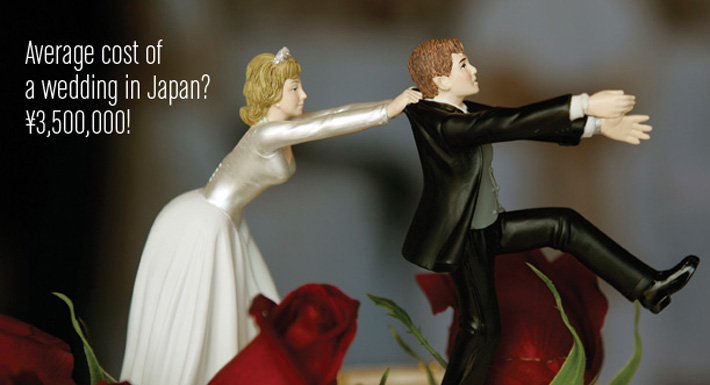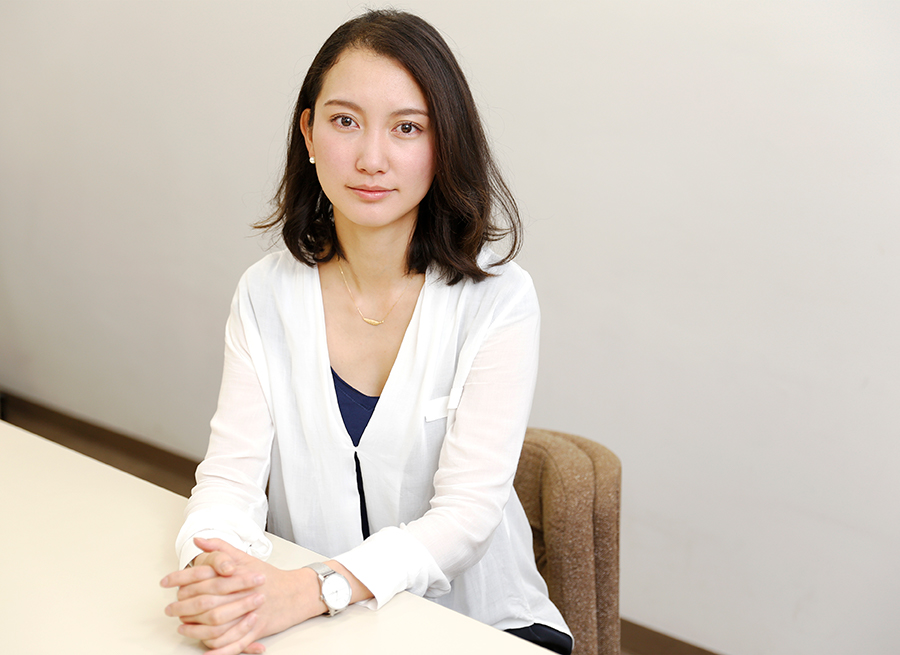Weddings: The beautiful sight of two loving humans celebrating the start of a new life together, for better or for worse, for richer and poorer… An age old tradition—and in Japan a multi-billion Yen industry.
Getting married in Japan is one of the most expensive ways to tie the knot. A huge service industry has bloomed around the business, from high-definition Blu-ray movies of the service, to parties involving multiple changes of dress, ring relays, cake cutting routines, gallons of champagne and pretend priests.
You may have noticed the numerous garishly designed mock chapels, churches and even entire faux European villages in the most mundane parts of Tokyo, but inside these structures hides a well oiled economic machine, providing an incredibly lucrative trade to the large corporations, who own them.
For couples looking to plan the big day marriage-bible Zexy—Japan’s largest wedding magazine provides guidance. The hefty 1000 page tome is dedicated to marriage venues, wedding tips and interviews, it is even sold with a specially reinforced carrier bag—as regular bags tear under the weight. Zexy covers 19 areas, including Tokyo, Kansai, Nagoya, Japanese resorts and overseas resorts and sells over 33,000 copies each year.
For a venue that seamlessly fuses commerce with matrimony try visiting Anniversaire, a French café in Omotesando that doubles as a wedding hall. The sips of lunch time coffee are punctuated by loud ringing—customers are provided a bell and asked to ring it when a newlywed couple walks through the restaurant.
Aoki, a leading formal wear company own many wedding halls and also provide catering services, staff and dresses, bu if a bride wants to wear her own wedding dress, instead of the corporate one, “there is often a fine involved”, explains Sanae Sato, an editor at 25ans—a luxury wedding magazine.
Many wedding dresses are imported from China or Europe and rented to brides—often being reused several times. Savvy salespeople could claim they are being eco-friendly, but really, it is just a smart business move. “Brides change clothes several times during the wedding day too, it can be very expensive”, says Sato.
In Japan there are fewer freelance wedding planners than in Europe or the US, “most are connected to the venue, they make sure your day goes smoothly”, and that you buy all of their products.
With transportation of relatives, hotel costs as well as fine food and alcohol, prices can soon mount up. Total costs for weddings can reach astronomical heights, “Our readers often spend in the region on ¥5,000,000”, says Sato.
As many Japanese are suffering in this post-credit crunch era, can such excesses be sustained?
Satoko Morishita, Editor in Chief of Zexy, sees more and more Japanese couples seeking to celebrate their wedding on a budget, “Our magazines number one topic is money and budgeting”,
For many couples, marrying on a shoe string is a real struggle, brides are often under immense pressure to conform to the standards set by large wedding corporations.
East meets West
For most Japanese people, the idea of marriage has been moulded by decades of cinema and story-book romances. The modern wedding ceremony is part tradition, part hollywood—and yet under the veil of commercialism is deep meaning.
Princess Masako’s Royal wedding in 1993 was a popular televised event that combined both Japanese and western formal traditions, and created a wave of copycat brides “It was like Cinderella, very beautiful—but today most young people don’t seem to care about history”, says Morishita.
These new marriage traditions are taken very seriously by Japanese couples, yet even the most established traditions, were often invented just a few years ago.
Changing Wedding Trends.
Western style weddings are immensely popular across the whole of Japan, in happo-en, near Shirokanedai you can clearly see Japanese wedding culture in action. Both a western style chapel and traditional Japanese shrine offer services side by side. “Western style is still more popular”.
 Some trends may seem a little strange to foreigners at first, but under the surface they are still very Japanese.
Some trends may seem a little strange to foreigners at first, but under the surface they are still very Japanese.
Zexy’s, third most popular topic is how to care for wedding guests. This aspect is taken very seriously by couples in Japan, who want to make the ceremony less about themselves and more about the whole family, “Weddings are a good time, much more than just two single people coming together, two families becoming one, it’s like a miracle”, says Morishita “The ceremony celebrates the family as well as the happy couple”.
New trends are emerging all the time and are often taken up by hotels and couples with the same zeal.
A popular trend at the moment is called ‘veil down’, “the mother of the bride covers her daughters face with a veil, then the father walks her down the aisle. This is quite new—each parent has a well defined role”.
Another booming trend is the ‘ring-relay’, where “every guest touches the wedding rings and passes them on to the next person, in turn all guests get to play an active role in the ceremony”.
The symbolic act of cake cutting also differs greatly from the western style; the Bridal association of America says “Cutting the cake and sharing the first bite with each other symbolizes the couple’s promise to share their new life together”.
Yet in Japan the newly-weds are more likely to be the last ones served food, as friends and family members eat first, “ the mothers of both the bride and groom serve the last piece to their children, the idea being that this symbolizes the last meal prepared by the family, now they are grown-up they must take care of themselves”, says Morishita.
What about the flip-side of the wedding industry—what happens when a marriage hits the rocks?
“Divorce is increasing in Japan. In the countryside, it is still very frowned upon, families still think it’s really bad, but numbers in big cities are growing”, she says. At least the second time round couples can marry in a smaller, less showy style, “Our reader survey found that people marrying for the second time often go abroad and don’t invite any guests—that way is much cheaper”.
External Link:
Zexy magazine










